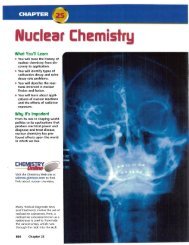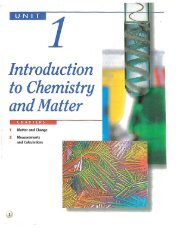Solutions
Solutions
Solutions
Create successful ePaper yourself
Turn your PDF publications into a flip-book with our unique Google optimized e-Paper software.
Hydrochloric Acid<br />
in Aqueous Solution<br />
37.5%<br />
HCI<br />
Mole fraction If you know the number of moles of solute and solvent, you<br />
can also express the concentration of a solution in what is known as a mole<br />
fraction-the ratio of the number of moles of solute in solution to the total<br />
number of moles of solute and solvent.<br />
The symbol X is commonly used for mole fraction, with a subscript to indicate<br />
the solvent or solute. The mole fraction for the solvent (X A ) and the mole<br />
fraction for the solute (X B<br />
) can be expressed as follows<br />
X HC1 + X H 0 =1.000<br />
2<br />
0.229 + 0.771 =1.000<br />
Figure 15-15<br />
The mole fraction expresses the<br />
number of moles of solvent and<br />
solute relative to the total number<br />
of moles of solution. Each<br />
mole fraction can be thought of<br />
as a percent. For example, the<br />
mole fraction of water (X H 0) is<br />
0.771, which is equivalent io<br />
saying the solution contains<br />
77.1 % water (on a mole basis).<br />
where n A is the number of moles of solvent and nB is the number of moles<br />
of solute. Why must the sum of the mole fractions for all components in a<br />
solution equal one<br />
Consider as an example the mole fraction of hydrochloric acid (HCI) in<br />
the aqueous solution shown in Figure 15-15. For every 100 grams of solution,<br />
37.5 g would be HCI and 62.5 g would be H 2 0. To convert these masses<br />
to moles, you would use the molar masses as conversion factors.<br />
1 mol HCI<br />
nHCl = 37.5.g..Her X 36.5.g-Hef =<br />
1.03 mol HCI<br />
1 mol H 2 0<br />
nH 2<br />
0 = 62.5 .g.-I-f2O X 18.0.g.-H1J = 3.47 mol H 2 0<br />
Thus, the mole fractions of hydrochloric acid and water can be expressed as<br />
1.03 mol HCI<br />
1.03 mol HCI + 3.47 mol H 2 0<br />
X HC1 = 0.229<br />
1.03 mol HCI + 3.47 mol H 2 0<br />
X H20<br />
= 0.771<br />
PROBLEMS<br />
26. What is the mole fraction of NaOH in an aqueous solution that contains<br />
22.8% NaOH by mass<br />
27. An aqueous solution of NaCI has a mole fraction of 0.21. What is the<br />
mass of NaCI dissolved in 100.0 mL of solution<br />
Assessment<br />
28. Distinguish between a dilute solution and a concentrated<br />
solution.<br />
29. Compare and contrast five quantitative ways to<br />
describe the composition of solutions.<br />
30. Describe the laboratory procedure for preparing a<br />
specific volume of a dilute solution from a concentrated<br />
stock solution.<br />
31. Thinking Critically Explain the similarities and<br />
differences between a 1M solution of NaOH and a<br />
1m solution of NaOH.<br />
32. Using Numbers A can of chicken broth contains<br />
450 mg of sodium chloride in 240.0 g of broth.<br />
What is the percent by mass of sodium chloride in<br />
the broth<br />
470 Chapter 15 <strong>Solutions</strong>












